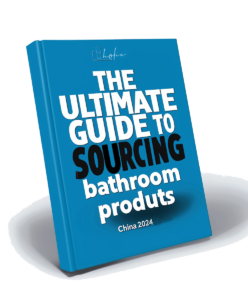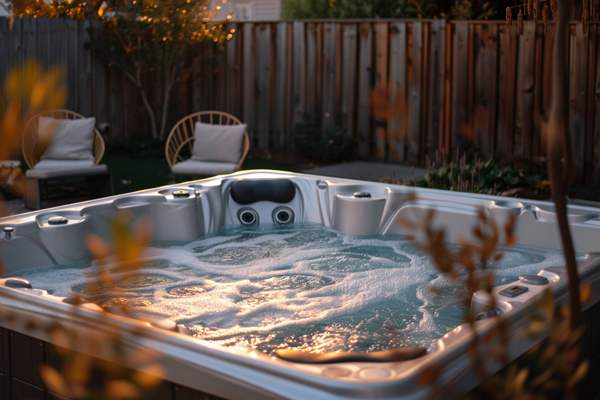
Pests ruin the hot tub experience. Let’s fix it fast.
Pests love warm water. Stop infestations with proper cleaning1, covers, and natural deterrents.
Don’t ignore the issue—keep reading for practical steps.
Why Are Pests and Insects Attracted to Hot Tubs?
Warmth and moisture are irresistible to bugs.
Pests are drawn by heat, water, and shelter around hot tubs.2
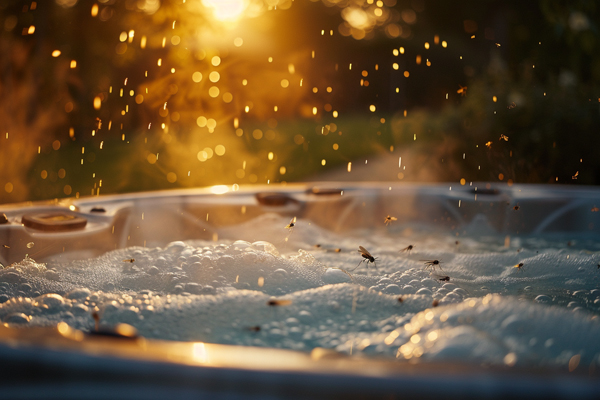
I’ve noticed bugs gathering around my hot tub, especially at night. It turns out insects and small animals are highly attracted to moist and warm environments. A hot tub provides both, along with cracks and hiding spots under the deck or cover.
They also seek standing water. Even a few splashes that don't evaporate can invite mosquitoes. The water’s warmth keeps them active during cooler nights, especially in spring and fall.
Rodents and ants might be looking for a heat source. When temperatures drop, they scout for insulated places. If your tub has foam insulation or a wooden frame, that’s even more inviting. Plus, food or drink spills make it worse.
Factors That Attract Pests
| Factor | Why It Attracts Pests |
|---|---|
| Warm water | Ideal for insects and rodents |
| Splash zones | Mosquito breeding grounds |
| Leftover food | Attracts ants and rodents |
| Cracks or crevices | Shelter for small creatures |
| Night lights | Draw flying insects |
To stop this, I learned to control moisture and remove anything that could serve as bait or shelter.
What Types of Pests Commonly Invade Hot Tubs?
Every hot tub area invites different bugs.
Ants, wasps, rodents, and mosquitoes often target warm and wet spa zones.

I’ve seen ants trailing along the edges of my hot tub, especially after rain. Rodents have once chewed through my cover’s corner foam. That was a wake-up call. Different pests target different hot tub parts depending on season and location.
Insects like mosquitoes breed in nearby puddles3. Spiders might make webs under the tub steps. Cockroaches can crawl through plumbing access panels. Rodents find shelter in insulation. Wasps may build nests near the corners or in the pump housing.
Understanding which pests are common helped me take better steps to deter them.
Common Hot Tub Pests
| Pest | Where They Appear | What They Do |
|---|---|---|
| Ants | Tub edges, steps | Bite, create trails |
| Mosquitoes | Around stagnant water | Bite, breed rapidly |
| Rodents | Underneath tub, foam corners | Chew wires, nest in insulation |
| Wasps | Tub corners, nearby bushes | Sting, build nests |
| Spiders | Steps, corners, access panels | Webbing, spider bites |
Knowing this list helped me stay on guard during peak seasons.
How Can I Prevent Bugs From Entering My Hot Tub Water?
Clean water is bug-free water.
Use a tight cover, clean filters4, and skim the surface to stop insect entry.

I’ve found that bugs love to float in the water, especially if the cover is left open overnight. Preventing this takes daily effort. First, I always keep the hot tub covered when not in use. Second, I make sure there’s no standing water on the lid, which can attract mosquitoes.
Third, I added a fine mesh to the intake vents to block insects. Skimming the water every day removes leaves and bug larvae before they become a bigger issue. I also check the filters weekly. Bugs often get trapped there, reducing efficiency.
Quick Tips to Prevent Bug Entry
| Action | Why It Works |
|---|---|
| Tight-fitting cover | Blocks bugs from entering |
| Regular skimming | Removes visible pests and debris |
| Clean filters | Keeps system efficient and hygienic |
| Drain standing water | Stops mosquito breeding |
| Cover when not in use | Prevents night-time intrusions |
A little discipline each day keeps the bugs away.
Do Hot Tub Covers Really Keep Insects and Rodents Away?
Covers help—but only if they fit and seal well.
Yes, hot tub covers5 can prevent pests if they’re in good condition and sealed tight.

When I first installed a hot tub, I used a generic cover. It didn’t seal properly, and rodents chewed through it within weeks. I later upgraded to a custom-fit insulated cover with locking straps. That made a huge difference.
Covers stop flying insects from landing in the water. They also block rodents and spiders from sneaking inside. But gaps in worn-out or warped covers make it useless. I now inspect my cover monthly for cracks, tears, or weak spots.
How a Cover Protects
| Feature | Pest Protection Benefit |
|---|---|
| Locking straps | Stops raccoons, rodents |
| Foam insulation | Deterrent to chewing animals |
| Tight edge seal | Blocks ants and flying insects |
| Waterproof surface | No water pooling for mosquitoes |
Good covers are the first line of defense.
How Should I Clean My Hot Tub to Deter Insects?
Clean tubs are less attractive to pests.
Regular cleaning removes odors, algae, and residues that lure insects and animals.

I once skipped maintenance for two weeks. When I returned, there were bugs, webbing, and even slime on the sides. That taught me the importance of consistent cleaning.
I now drain and clean the tub every 2–3 months. I scrub the shell with non-toxic cleaner, flush the plumbing, and clean the filters. Between major cleans, I sanitize the water with bromine6. Bugs hate clean, moving water.
I also wipe down the area around the tub. Crumbs or drink spills attract ants fast. After each use, I rinse off the steps and decking to keep the entire zone unattractive to pests.
My Cleaning Routine
| Task | Frequency |
|---|---|
| Skim water | Daily |
| Sanitize with bromine | 2–3 times a week |
| Clean filters | Weekly |
| Drain and scrub tub | Every 2–3 months |
| Rinse surrounding deck | After every use |
Clean hot tubs are unappealing to bugs.
What Natural Repellents Work Best Around Hot Tubs?
Nature gives us safe pest control options.
Essential oils, herbs, and natural sprays help repel bugs without harming your spa water.

I prefer not to use strong chemicals near my spa, especially when I’m soaking in it. Over time, I’ve experimented with natural repellents that work surprisingly well.
Lavender and peppermint oils repel ants and mosquitoes. I mix a few drops in water and spray it around the base of the hot tub. I’ve also planted citronella and lemongrass nearby. These herbs discourage flying bugs.
For wasps, I hang decoy nests—they hate competition. Cinnamon powder at corners seems to keep ants at bay too. I stay away from garlic-based sprays since they smell too strong.
My Go-To Natural Repellents
| Ingredient | Pest It Repels | How I Use It |
|---|---|---|
| Lavender oil | Mosquitoes, flies | Mixed in water spray |
| Peppermint oil | Ants, spiders | Cotton balls near tub corners |
| Citronella plant7 | Flying insects | Planted near spa area |
| Vinegar-water mix | General repellent | Surface cleaning spray |
Natural methods are safe and effective when used often.
Can Landscaping Around My Hot Tub Attract or Repel Pests?
Your yard can make or break pest control8.
Yes, plants, rocks, and mulch affect pest levels near your hot tub. Choose them wisely.

I once used bark mulch around my spa—it became a home for ants. Since then, I’ve switched to gravel, which doesn’t hold moisture or attract bugs.
I also trimmed back plants that touched the tub. Branches act like bridges for spiders and ants. I now keep a clear buffer zone of about 2 feet around the tub. That change alone made a big impact.
Plants like basil and rosemary help repel bugs. But water-loving plants can attract mosquitoes, so I avoid them near the spa.
Landscaping Choices That Matter
| Feature | Pest Impact |
|---|---|
| Bark mulch | Attracts ants and termites |
| Gravel or stone | Drains well, repels pests |
| Shrub clearance | Reduces entry points |
| Bug-repelling herbs | Naturally deters insects |
Landscaping isn't just for beauty—it’s pest prevention too.
How Can I Spot Signs of Pest Infestation in My Hot Tub Area?
Early signs save big repair bills.
Watch for droppings, chew marks, webs, and strange noises near your hot tub.

One morning I found chewed wiring near my pump panel. It was a rodent infestation I could’ve caught earlier. Now, I check weekly for warning signs.
If I see insect trails9, especially ants, I know there's a nest nearby. Webbing indicates spiders. Mosquitoes buzz more around dusk. Rodent droppings are small, dark pellets—usually near base corners. Chew marks on foam or wires are a big red flag.
I also listen. If I hear scratching or rustling from under the tub, that’s a serious clue. Acting fast prevents long-term damage.
Warning Signs to Watch For
| Sign | Likely Pest |
|---|---|
| Chew marks | Rodents |
| Ant trails | Ant colonies nearby |
| Droppings | Mice or rats |
| Webs | Spiders |
| Buzzing sounds | Mosquitoes or flies |
Being observant can stop an infestation early.
Is It Safe to Use Chemical Insecticides Near My Hot Tub?
Only with caution.
Yes, but always choose spa-safe products10 and avoid direct water contact.
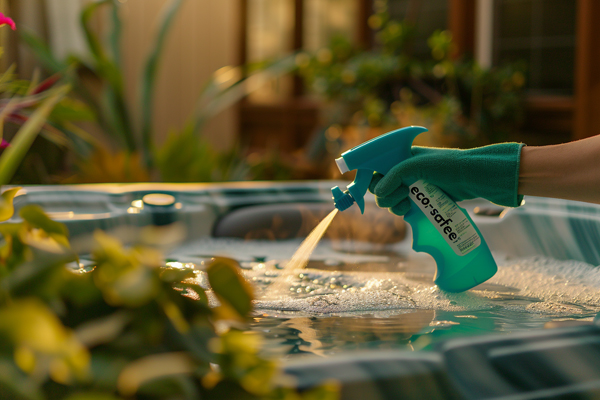
I’ve used chemical sprays, but only carefully. They work fast, especially for wasps or ants. But I always spray away from the tub’s edge and never on surfaces where I sit or soak.
Granular treatments for ants work better near the base. I also use gel baits for roaches, placed behind panels where kids or pets can’t reach. I make sure nothing drips into the water.
If I need to use foggers, I fully cover the hot tub and wait 24 hours before using it again. Always follow labels.
Safe Chemical Use Tips
| Product Type | Usage Zone | Safety Notes |
|---|---|---|
| Ant granules | Perimeter soil | Keep 2 ft away from spa |
| Gel baits | Inside cabinets | Avoid children/pets contact |
| Surface sprays | Nearby walls/floor | Never spray directly on tub shell |
| Wasp sprays | Nest sites only | Remove residue before spa use |
Use chemicals only when necessary and with great care.
What Maintenance Habits Keep Bugs Away From Outdoor Spas?
Consistency wins every time.
Daily and weekly habits prevent infestations and save money over time.
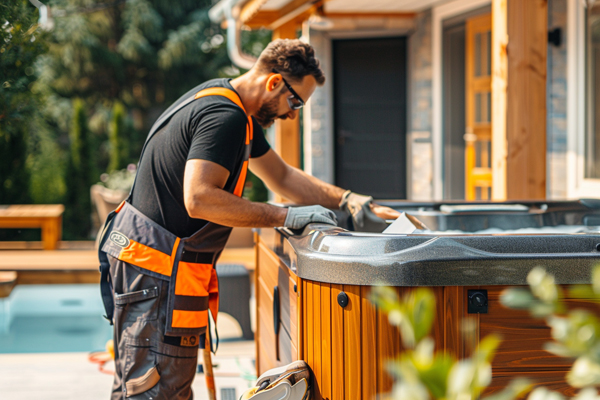
I've made pest prevention part of my weekly spa routine. After every soak, I skim the water, wipe down surfaces, and cover the tub. Every Sunday, I clean the filters and check for signs of pests.
I also inspect the cover for wear and seal the deck area if needed. Small cracks become bug highways. Once a month, I spray natural repellents11 and refresh mulch-free zones.
My Maintenance Schedule
| Task | Frequency |
|---|---|
| Skim and wipe down | After each use |
| Inspect for pests | Weekly |
| Clean filters | Weekly |
| Check cover condition | Monthly |
| Reapply repellents | Monthly |
Routine prevents surprises later.
Should I Call a Professional for Hot Tub Pest Problems?
Yes, when DIY fails.
Call an expert if pests damage your hot tub or infestations keep returning.

Once, I tried everything, but rodents kept chewing under my tub. A pest control expert12 found a nest deep under the decking and sealed it properly. That ended months of frustration.
Professionals know where to look. They also use safer chemicals and prevent future outbreaks. If pests cause damage to wiring, foam, or plumbing, don’t wait.
Calling early avoids expensive repairs and health hazards.
When to Call a Pro
| Situation | Reason to Call |
|---|---|
| Chewed wires or insulation | Fire risk |
| Repeated infestations | Hidden nests |
| Large nests (e.g., wasps) | Safety concern |
| Pest-related water damage | Plumbing risks |
Sometimes, it’s worth every penny.
What Are the Risks of Ignoring Insects in My Hot Tub Area?
Health and damage risks grow fast.
Bugs can contaminate water, cause structural damage, and create health hazards if ignored.

I used to brush off a few ants or bugs. But when wiring got damaged and repairs cost me hundreds, I realized the real risks.
Mosquitoes carry diseases. Rodents chew insulation and wiring. Spiders bite. Ants may cause structural damage under the deck. All of these affect not just the tub, but also user health and safety.
Ignoring pests is not just inconvenient—it’s expensive and risky.
Risks of Ignoring the Problem
| Problem | Potential Impact |
|---|---|
| Contaminated water | Skin infections, illness |
| Chewed components13 | Electrical faults, leaks |
| Bites or stings | Allergic reactions, discomfort |
| Nesting in foam or wood | Structural degradation14 |
Stay ahead of bugs before they bite back.
Conclusion
Keeping pests out of your hot tub isn’t about one-time fixes. It requires daily care, regular cleaning, the right cover, and smart use of natural or chemical repellents. Landscaping choices and early detection also matter more than most people realize. When these steps are followed consistently, your hot tub stays clean, safe, and relaxing. But if ignored, even small bugs can lead to serious damage and expensive repairs.
-
Learn the best cleaning practices to maintain your hot tub and prevent pest infestations effectively. ↩
-
Understanding what attracts pests can help you prevent them from invading your hot tub area. Explore this link for effective pest control strategies. ↩
-
Understanding mosquito breeding habits can help you prevent them from invading your hot tub area. Check out this resource for more information. ↩
-
This link will guide you on the best practices for maintaining clean filters, ensuring your hot tub remains bug-free and efficient. ↩
-
Explore this link to understand how hot tub covers can effectively protect against pests and enhance your hot tub experience. ↩
-
Learn how bromine works to keep your hot tub water clean and safe, deterring insects and enhancing your bathing experience. ↩
-
Learn how citronella plants work to repel insects and enhance your outdoor experience, especially around hot tubs. ↩
-
Explore this link to discover proven pest control strategies that can enhance your landscaping efforts and protect your hot tub. ↩
-
Recognizing insect trails can help you locate nests and take action before an infestation occurs. ↩
-
Explore this link to find the best spa-safe products that ensure your hot tub remains safe while effectively managing pests. ↩
-
Discover effective natural repellents that can help keep your outdoor spa pest-free without harmful chemicals. ↩
-
Explore this link to understand how a pest control expert can effectively resolve hot tub pest issues and prevent future infestations. ↩
-
Learn how chewed components can lead to serious safety issues and costly repairs in your hot tub. ↩
-
Preventing structural degradation is crucial for the longevity of your hot tub; explore effective prevention strategies. ↩


